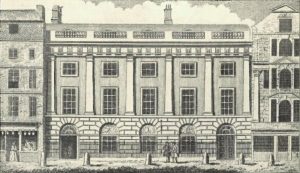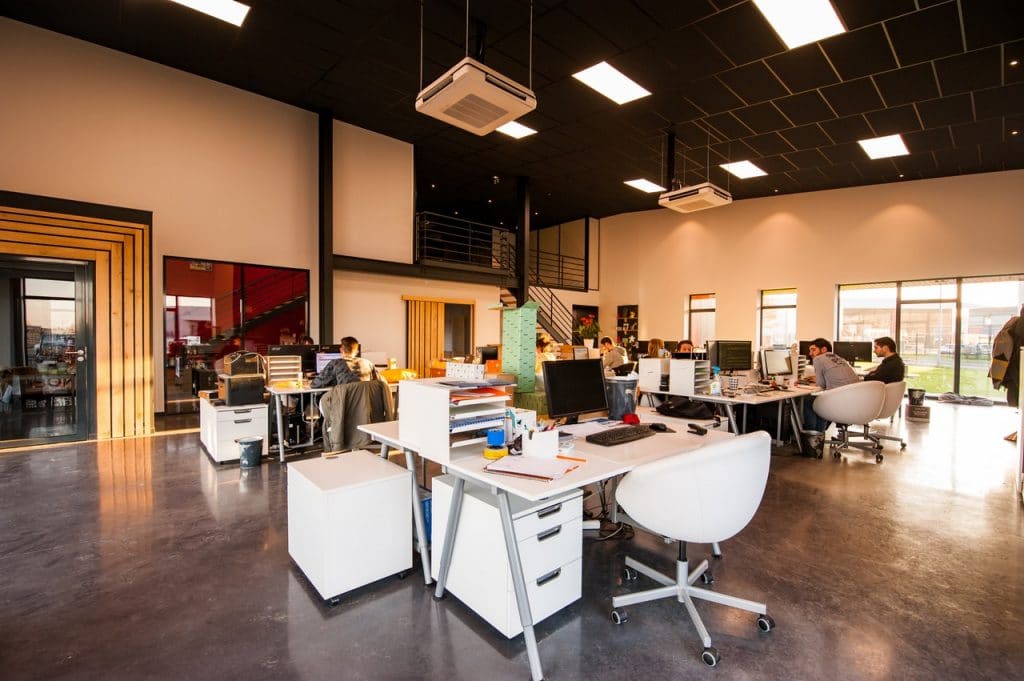We sit in them almost every day, we build a whole life around them. They see romance, fall outs, takeovers and epic fail. But how much do we really know about our office environment? How did we end up here?

You could say that the office environment dates back as far as time. With even the Egyptians having rooms dedicated to the ‘admin’ of running empires.
That said however we would probably be safer to consider the ‘modern’ office as being born around the 18th century with the development of the East Indian Shipping Company.
The Old Admiralty (Ripley Building) was built in 1726 as a three-storey U-shaped brick building. This was the first purpose-built office building in Great Britain. The East India House was built in 1729 on Leadenhall Street. This was the headquarters from which the East India Company administered its Indian colonial possessions.
The Office Environment During The Industrial Revolution
With the Industrial Revolution in the 18th and 19th centuries came the expansion of rail, insurance, banking and retail (to name a few). To transact business, we suddenly needed ‘clerks’ for order processing, accounting, documentation etc. and a specialised office was required.
Offices were full of heavy dark furniture, storage spaces, mountains of paper and later telephones. Office clerks worked 6 days a week often 12 hours a day. Most lived in walking distance or perhaps a small commute via rail, carriage or bicycle.

Fast forward to the mid-20th century and offices are a well-established place of work. Often filled with men in suits and ladies in front of typewriters we start to see a shift with the invention of the word processor.
No this wasn’t the first bit of electronic kit that promised to change the way offices worked forever, in fact, 1951 It was a British tea shop and catering chain that developed the first computer for business use. It wasn’t until the 70’s however that things began to ramp up.
Processors were suddenly able to do a lot of grunt work for us, albeit with help from the office secretary.
Open plan offices come into force through the ’70s and ’80s and as computers begin to take on more and more of the admin load, we see a decrease in the office secretary and an increase in the IT help desk!
The Modern Office Environment As We Know It
By the 80’s we are still far from a paperless office, emails were still few and far between and much work was still being dealt with in some capacity by hand, and we were using our electric shredders which up until now had only been in the realm of governments and the secret service.
It wasn’t until ’90s and well into the 00’s that we begin to see a computer on every desk. Up until the mid-’90s development of the office and office equipment had been at a steady rate. Then came technology advances that completely overthrew the old way of working.

From photocopies and faxes, we went to blackberries, email, video conferencing, cloud technology, wi-fi and suddenly being able to work from your local café.
The ability to hotdesk is now a reality. However, workers based in the office are still the norm. We have also shifted our opinions on paper, and although the paperless office still seems like a lifetime away, a focus on the environment along with digital capability is now seeing it as a possibility.
The Office Time Line
Office life in the 1950s
- 43 hrs average working week
- Formal and conservative dress code
- Less than 30% of the workforce of women
- Large offices for most successful, open plan for everyone else
- Manual filing
- Smoking is allowed
Office life in the 1960s
- 41 hrs average working week
- Dress code is still formal however more colourful
- 33% of the workforce are women
- We see the emergence of cubicles for open-plan offices
- Fax machines
- Smoking is still around and we now see a more social element with the after work drinks
Office life in the 1970s
- 40 hrs average working week
- Dress code is suits for men. However, women can now be seen in trousers too
- 38% of the workforce are women
- A more relaxed attitude towards lunch hours and less formality can be seen
- We see ergonomics in office furniture
- Massive computers
- Recycling
Office life in the 1980s
- 43 hrs average working week – a sudden leap back up
- Suits are still the norm however women are seeing more options and brighter colours are popular
- We now have 43% of women in the workforce with increasing opportunities for higher roles
- Power and money become key, middle management has a say on how things are done
- Computers are still large but we are seeing more of them
- Fax machines are now being used
Office life in the 1990s
- The working week goes down to a low of 39 hrs
- Office attire is now varied but still with a formal twist, some offices adopt a dress down Friday option
- Women still make up 43% of the workforce
- The use of floppy disks comes into play with more computers being on desks
- Mobile phones start to become more commonplace for middle management as well as high profile employees
Office life 00’s and beyond
- 38 hrs average working week
- A home office is now an option with startups in technology popping up
- Many offices and startups adopting a more casual view on clothing, tattoos, dyed hair and piercings
- Smartphones revolutionise not only the office and work environments but our lives
- Laptops and wifi make the prospect of working from anywhere even more possible
- The ‘self-employed’ option and the multi-hyphenated worker is becoming popular
- A focus on environmental issues is increasing the need to recycle and go paperless
- Social media and multilevel marketing are becoming more and more of a focus for business
What does the future hold? Virtual reality meetings? 3D printing your own office chair? Who knows!

